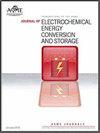RED-MED盐度梯度热机的模拟研究:常规方案和改进方案
IF 1.9
4区 工程技术
Q3 ELECTROCHEMISTRY
Journal of Electrochemical Energy Conversion and Storage
Pub Date : 2022-11-17
DOI:10.1115/1.4056270
引用次数: 0
摘要
近年来,反电渗析-多效蒸馏(RED-MED)热机由于能够将低温废热转化为盐度梯度能量,然后从中提取电力而受到越来越多的关注。研究了RED通道长度和进料流量对耦合系统性能的影响。此外,在文献中,离开RED的两股物流中,只有一股(即稀释液或浓缩液)在MED处理前被分流并与另一股物流部分混合。本文提出了一种改进方案,即两股物流都被分流,即只有一部分浓缩液溶液与一部分稀释液混合。改造的目的是进一步降低MED的总流量。改造后,MED的能效和换热面积要求都有所提高。讨论了分裂分数的最佳值。结果表明,虽然文献中报道的研究主要集中在与RED部分密切相关的方面,但也应注意RED-MED耦合系统的总体方案设计。本文章由计算机程序翻译,如有差异,请以英文原文为准。
A Modeling Study of RED-MED Salinity Gradient Heat Engine: the Conventional Scheme and A Modified Scheme
Reverse electrodialysis - Multi-effect distillation(RED-MED) heat engine has received increasing attention in recent years, due to its ability of converting low temperature waste heat into salinity gradient energy, and then extracting electric power from it. In this work, the RED-MED coupled system was studied with a mathematical model, which was validated by our experimental results. The influences of RED channel length and the feed flow rate on the performance of the coupled system were studied. Furthermore, in the literature, only one of the two streams leaving RED, i.e. either the dilute or the concentrate, is split and partly mixed with another stream before being treated in MED. In this paper, a modified scheme is proposed, in which both the two streams were split, i.e. only a fraction of the concentrate solution was mixed with a fraction of the dilute. The purpose of the modification is to further reduce the total flow rate in MED. After the modification, both the energy efficiency and the heat exchange area requirement of MED increase. The optimum value of the split fraction was discussed. Results imply that while the studies reported in the literature mainly focus on the aspects closely related to the RED section, attention should also be paid to the overall scheme design of the RED-MED coupled system.
求助全文
通过发布文献求助,成功后即可免费获取论文全文。
去求助
来源期刊

Journal of Electrochemical Energy Conversion and Storage
Engineering-Mechanics of Materials
CiteScore
4.90
自引率
4.00%
发文量
69
期刊介绍:
The Journal of Electrochemical Energy Conversion and Storage focuses on processes, components, devices and systems that store and convert electrical and chemical energy. This journal publishes peer-reviewed archival scholarly articles, research papers, technical briefs, review articles, perspective articles, and special volumes. Specific areas of interest include electrochemical engineering, electrocatalysis, novel materials, analysis and design of components, devices, and systems, balance of plant, novel numerical and analytical simulations, advanced materials characterization, innovative material synthesis and manufacturing methods, thermal management, reliability, durability, and damage tolerance.
 求助内容:
求助内容: 应助结果提醒方式:
应助结果提醒方式:


